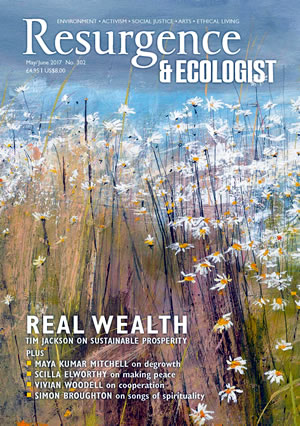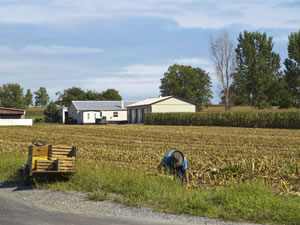“This is the new normal,” said Governor Jerry Brown of California in April 2015, while standing in dry brown grass on a Sierra Nevada peak that would normally be covered with five feet of snow at that time of year. “We will learn how to cope with this,” the governor announced, as he ordered revolutionary mandatory water restrictions for his drought-stricken state.
The challenge of coping with the new normal of climate change has been notably taken up by philanthropists and funders. In one such announcement, Bill Gates, Microsoft co-founder and one of the world’s richest men, grabbed headlines with his unveiling of a new consortium to finance high-tech, clean energy research.
Gates’ willingness to commit his wealth to the climate arena is laudable. Against the odds, this research may eventually give results. Yet we urgently need solutions we can use now. These exist, and many of the best surprisingly hail from the realm of low tech.
Reporters, scientists and government officials are increasingly describing routine catastrophes, using Brown’s terminology, as “the new normal”. In a typical piece, Scientific American used the term in August 2016 to describe the catastrophic flooding experienced across the USA. Similarly, from torrential rains during the summer harvest in Myanmar to wildfires in California, from floods in Louisiana to crushing drought in Pakistan, from sea level rise causing storm surges in New Zealand to beach erosion around the world, the new normal is here to stay.
Climate change related to the unchecked burning of fossil fuels is playing out even worse than climatologists’ models. Its effects are exacerbated by growing populations, increased urbanisation, poor development, the spread of epidemic diseases such as dengue fever and Zika virus, and the destruction of protective natural ecosystems.
Most of today’s new normal events are far beyond quick fixes. No advanced technology exists now or will exist in the foreseeable future that can increase winter snowfall in the mountains, alter the course of a hurricane, or reduce sea level. In dealing with the problems caused by climate change and resource exhaustion, high tech has distinguished itself primarily by its promises, like the perennial promise of fusion power.
Even if technology cannot eliminate new normal events, it doesn’t necessarily mean they must end in disaster. If we can reduce the human effects of these unstoppable events, we will reduce the number of disasters. So how can this be done?
Disaster managers use a common-sense equation to evaluate the risk posed by natural disasters: Risk = Hazard x Vulnerability. If we lower the risk, we lower the likelihood of human disasters. Hazards, the new normal events, are beyond our control. Therefore we must reduce our vulnerability. Doing so can reduce risk even in the face of increased hazards.
What could reduce our vulnerability? Happily, methods abound. They include an abundance of low-tech strategies that can be implemented at the local level. ‘Low-tech’ here denotes mitigation tools that are relatively inexpensive, broadly accessible, and do not depend on highly engineered solutions. These include education, constructive land use, conservation and protective zoning, as well as community adaptation and preparedness.
Climate-change-induced drought, for example, is a hazard that the city of Seattle, in the north-western US state of Washington, may face. Seattle’s population has been growing: normally, we would expect a higher demand for water. But water usage there today is well below that of the late 1980s, despite a significantly higher population. The key here lies in widespread adoption of two low-tech devices: low-flow showerheads and low-flow toilets. Such measures are inexpensive and can easily scale from towns to megacities. Similar low-tech changes helped Australia cope with its 1997–2009 Millennium Drought.
During the 2014 Ebola epidemic, a major push by the US military to curb the disease in West Africa spent US$360 million, only to see its new clinics sit nearly empty. According to local sources, what actually stemmed the tide of the epidemic were community-based, low-cost, low-tech methods. Communal volunteer task forces equipped with vans, megaphones, buckets and bleach spread information, disinfected public spaces and taught local villagers how to manage the disease.
Public education also lacks the glamour of high-tech fixes but is simple and egalitarian and has an unassailable track record. During the March 2011 tsunami in Japan, the city of Kamaishi was destroyed despite being “protected” by a sea wall constructed at a cost of US$1.5 billion. Over 1,000 people died, yet only five of them were schoolchildren (and they were not in school that day). A wise, comprehensive programme of school education about disaster response, in which schoolchildren had been taught how, collectively, to take the initiative during crises, enabled immediate school evacuation. This saved the lives of over 3,000 children, including young and disabled children, who evacuated together in an orderly group to high ground. The Japanese government called this “The Miracle of Kamaishi”.
During the 2013 Typhoon Haiyan in the Philippines, thousands of people in and around the city of Tacloban died, many from flooding and storm surges. This disaster was attributable not only to a technological failure (unpredicted storm surge) but also to a social one: residents fearful of displacement did not heed evacuation orders. In the following year’s Typhoon Hagupit, the Philippine government was ready. Improved forecasting ability was in place, complemented by an intensive effort to educate citizens about disasters and the need to evacuate before the storm. This combination of technological and public education strategies yielded a vastly lower death toll.
If indeed more frequent and severe climate and disease events are our new normal, the aforementioned experiences suggest that citizens and governments alike should develop new principles for preparedness.
First, we do not need to wait for forthcoming high-tech or national-level solutions to disasters: many alternatives are already here. Practical tools for individuals, farms and cities alike can effect drastic cuts in water or energy consumption, enact flood preparedness, and ready citizens for hazards. Best practices in zoning and land use can make the difference between a storm and a flood, between a dry year and a parching drought. As described in the Ebola case, low-cost community disaster education is not a theoretical solution: it has saved many lives.
Harnessing the power of community-based resilience can drastically lower vulnerability. The farmer and writer Gene Logsdon analysed the remarkable success and durability of Amish farms in the United States. He pointed out that while modern neighbouring farms were going bankrupt because of catastrophic weather- and pest-related failures of their single crops, the Amish farmers stayed comfortably solvent. This was because the community as a whole could sell a wide variety of produce and products, from milk to beef to wool, honey, quilts, and even farm tours. Social networks were as important as agricultural practices in providing the self-insured Amish with catastrophe protection, a finding that has recurred in nearly all studies of disaster-resilient communities worldwide.
In 1943, during the second world war, in a dramatic example of community resilience, following the example of President Franklin Roosevelt’s wife Eleanor, nearly 20 million small “victory gardens” produced an astounding 30–40% of America’s vegetables. Low tech, high yield.
Second, we should use or protect Nature when possible. Many studies have shown that native ecosystems such as mangroves, sand dunes and barrier islands can effectively and economically forestall storm surge and coastal flooding. Such features are cheaper and often more effective than ruinously expensive sea walls. Also, we should plant crops that are part of the natural vegetation and need minimal irrigation or herbicide. When possible, we should preserve native habitats. As analyses of flood patterns in suburban New Jersey show, flooding caused by widespread tree removal could have been largely averted through judicious preservation of small forests and forested corridors.
Experience has shown that the best strategy to prevent massive wildfires, particularly in coniferous forests, is to reproduce the historical fire regime. If carefully managed, small, controlled burns can consume much of the fuel that would otherwise support huge fires, while preserving the natural fire cycle.
Third, we will have to make sacrifices. The luxury-level standard of living to which many people, especially in the United States, have become accustomed will need to change, particularly in hazard-prone regions. No longer can the American Southwest support the unlimited water use of its citizens. No longer can desert land be irrigated to sustain particularly thirsty crops such as peaches, whose growth consumes 1,180 litres of water per kilo of fruit. Coping with the new normal demands a realistic appraisal of what we really need and what our natural world is able to bear.
Some disasters will remain inevitable. Yet with cooperation we can repair or prevent most natural and human damage to ecosystems, or can leave them to repair themselves. The new normal is here, and it is one of flood, fire and drought. Yet even as we contemplate the grim reality of climate change, the inexhaustible resourcefulness and adaptability of our communities are a ray of hope. Whether in Manila or Los Angeles, committed communities have in common low-tech, affordable and effective methods to mitigate the unfolding crisis.
We hope that a cheap, efficient and carbon-neutral energy source can be discovered. But instead of waiting for a distant breakthrough, we also need philanthropists and governments alike to recognise that the new normal demands action now. The low-tech resources at our disposal for reducing disaster vulnerability are numerous and effective. They are made more so by strong, tight-knit communities. We can cope with the new normal. We already have the tools.








